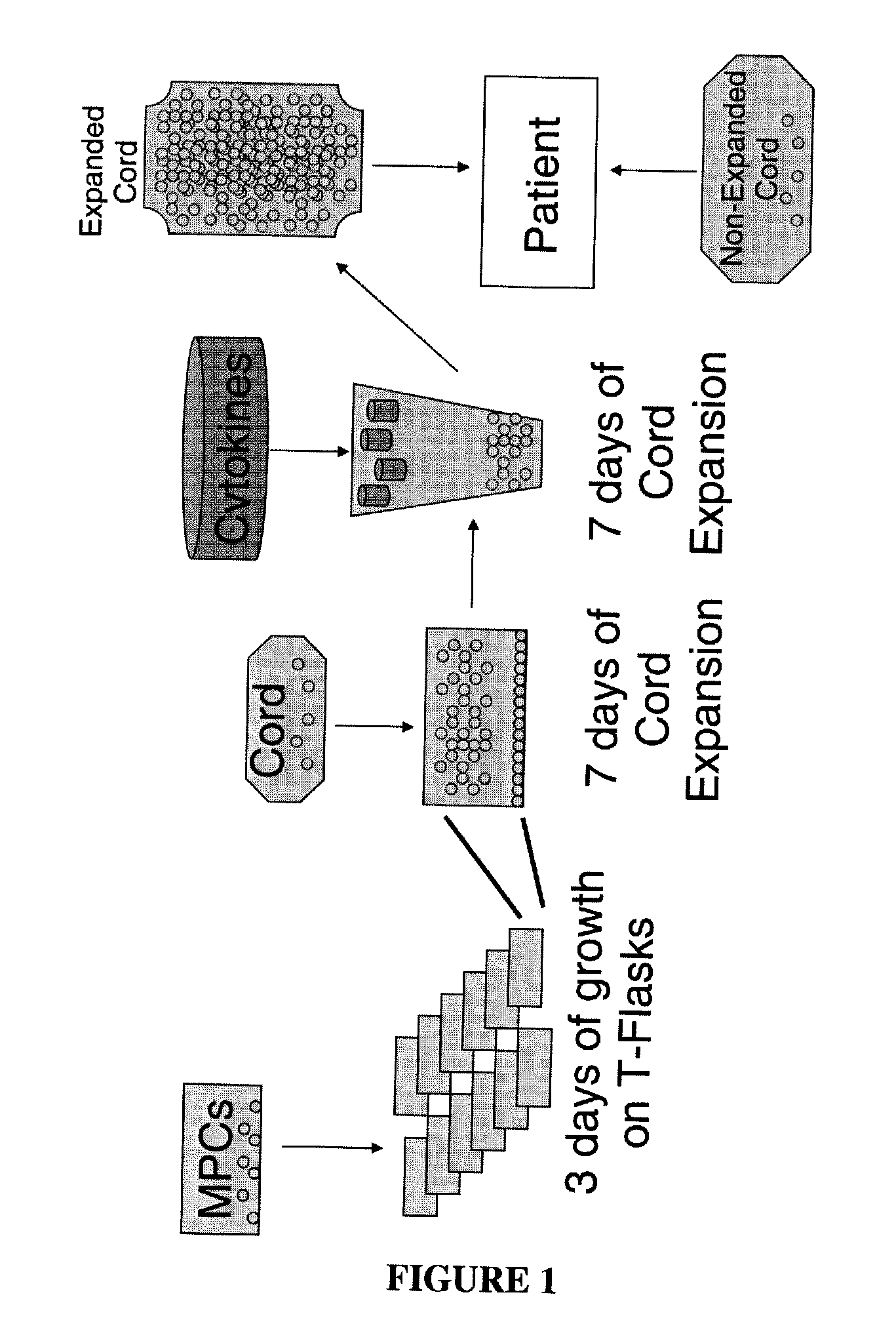Expansion of haemopoietic precursors
a technology transplantation method, which is applied in the field of transplantation can solve the problems of high engraftment failure rate, large cell dose not generally available for patients weighing more than 45 kg, and slow engraftment time, so as to reduce the likelihood of relapse, reduce the likelihood of manipulation and loss of haematopoietic precursor cells, and bypass disease-related
- Summary
- Abstract
- Description
- Claims
- Application Information
AI Technical Summary
Benefits of technology
Problems solved by technology
Method used
Image
Examples
example 1
Comparison of “Off-the Shelf” Allogeneic MPCS with Autologous MSCS
[0093]Cord blood (CB) co-cultured with MSCs generated de novo from bone marrow was compared with cord blood co-cultured with the Applicants “off-the-shelf” MPCs (Robinson et al., 2007).
[0094]MSCs are generated de novo from bone marrow as follows. Approximately 80-100 ml of marrow is aspirated into sterile heparin-containing syringes and taken to the MDACC Cell Therapy Laboratory for MSC generation. The bone marrow mononuclear cells are isolated using ficoll-hypaque and placed into two T175 flask with 50 ml per flask of MSC expansion medium which includes alpha modified MEM (αMEM) containing gentamycin, glutamine (2 mM) and 20% (v / v) fetal bovine serum (FBS) (Hyclone).
[0095]The cells are cultured for 2-3 days in 37° C., 5% CO2 at which time the non-adherent cells will be removed; the remaining adherent cells will be continually cultured until the cell confluence reaches 70% or higher (7-10 days), and then the cells wil...
example 2
Time to Generation of Sufficient Numbers of “Off the Shelf” MPCs for Cord Blood Co-Culture
[0097]One vial containing frozen human mesenchymal precursor cells (Lot No. 25126787, >1.5×107 cells / ml) was thawed and 2.03×106 cells recovered into 360 mls of alphaMEM medium supplemented with antibiotics (penicillin and streptomycin), glutamine and 10% (v / v) fetal bovine serum (FBS). The cell suspension was then distributed between 12×T-150 cm2 tissue culture flasks (approximately 1.7×106 cells per T-150 cm2 tissue culture flask). Cultures were monitored using inverted, phase contrast microscopy. Four to five days after initiation of the culture, the MPCs were >70% confluent and could be used for cord blood mononuclear cells (MNC) co-culture expansion. Accordingly, it is likely that the cultured MPCs would be sufficiently confluent by four days after initiation of the culture. This indicates that a single vial of off-the-shelf MPCs are sufficient to generate sufficient numbers of cells for c...
example 3
Cord Blood Transplantation Protocols
3.1 Double Cord Blood Transplants
[0098]In an attempt to increase the number of CB cells infused following high-dose or nonmyeloablative therapy, investigators have combined two units of differing HLA types and infused them as allogeneic hematopoietic support. These investigations support the principle that transplantation of two immunologically distinct CB units is safe in terms of crossed immunological rejection. Graft failure was not observed, but the majority of patients did engraft with only a single CB unit. In the current trial we will use two CB units, one of which will be expanded ex vivo in attempt to reduce the time to engraftment in CB transplant recipients below the 20-30 days typically reported in this setting.
3.2 Growth Factors for Ex-Vivo Expansion
[0099]The CB cells will be cultured with very low concentrations of the growth factors described in this section (nanogram concentrations as opposed to the microgram concentrations used sy...
PUM
| Property | Measurement | Unit |
|---|---|---|
| time | aaaaa | aaaaa |
| temperature | aaaaa | aaaaa |
| concentrations | aaaaa | aaaaa |
Abstract
Description
Claims
Application Information
 Login to View More
Login to View More - R&D
- Intellectual Property
- Life Sciences
- Materials
- Tech Scout
- Unparalleled Data Quality
- Higher Quality Content
- 60% Fewer Hallucinations
Browse by: Latest US Patents, China's latest patents, Technical Efficacy Thesaurus, Application Domain, Technology Topic, Popular Technical Reports.
© 2025 PatSnap. All rights reserved.Legal|Privacy policy|Modern Slavery Act Transparency Statement|Sitemap|About US| Contact US: help@patsnap.com


